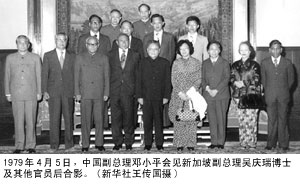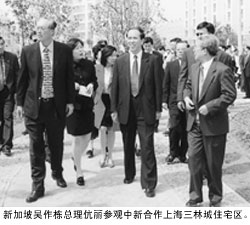 |
 |
 |
 |
 |
 |
 |
 |
 |
 |
 |
 |
|
|
Sino-Singapore Relations: Looking Back and Looking Forward Professor John Wong |
||||||||||||||||||||||||||||||||||||||||||||||||||||||||||||||||||||||||||||||||||||||||||||||||||||||||||||||
|
Pragmatism and Pragmatism China's relations with Southeast Asia, traditionally called Nanyang ("South Sea") by the Chinese, are extensive and deep-rooted on account of history, geography and migration. After the formation of the People's Republic in 1949, the relations assumed new dimensions, with complex ideological and geo-political forces coming into play, and this gave rise to more than two decades of Cold War relations. It was not till the early 1970s, with the advent of international détente, before individual Southeast Asian countries started to normalize relations with China.
On the other hand, Singapore's relations with China, has also been guided by a high sense of pragmatism. In separating trade from politics, pragmatism had enabled Sino-Singapore relations to survive the Cold War period. In the 1950s and 1960s when China's trade with Indonesia, the Philippines and Thailand was either seriously disrupted or banned altogether, China's trade with Singapore continued uninterrupted. In fact, for three decades from 1950 to 1990, Sino-Singapore trade was conducted in the absence of a formal diplomatic framework. After 1979, with the start of economic reform and open door policy under the leadership of Deng Xiaoping, China's approach to foreign relations was also characterized by pragmatism. This led to further growth of the two-way relations between China and Southeast Asia (or ASEAN) in general and between China and Singapore in particular. Singapore really rose to the occasion and seized the opportunity to expand its economic ties with China, especially after Deng's tour of South China in early 1992. Accordingly, Singapore has now become China's seventh largest trading partner and fourth largest investor in China. Singapore's trade with China constitutes the bulk of the overall Sino-ASEAN trade. Singapore has in fact established itself as another gateway to China after Hong Kong. On her part, China's economy is also slowly "looking south". Many Chinese state-owned enterprises have also established branches in Singapore. As the Chinese are becoming more affluent and as they start taking trips overseas, Singapore on account of its unique image as a garden city, clean and safe, has become a prime destination for the first-time Chinese tourists. In 1999, Singapore received a record 373,000 Chinese tourists, the fourth largest source of visitor arrivals after Japan, Australia, and U.K. On the political level, China and Singapore have continued to maintain a warm relationship ever since the beginning of international détente in the 1970s, in part because there are no outstanding issues and no areas of open conflict between them. Following Deng Xiaoping's remark in his Nanxun speech in early 1992, which singled out Singapore as a country that had achieved successful economic development along with a high degree of social order, China had organized numerous official "observation tours" to Singapore to study Singapore's development experiences. Over the years, many Chinese political and Party leaders, including virtually all the Politburo members, senior members of the National People Congress (NPC) and the Chinese People's Political Consultative Congress (CPPCC) have visited Singapore. In return, most of Singapore's Cabinet ministers and senior civil servants have also visited China. In fact, Prime Minister Goh Chok Tong and Senior Minister Lee Kuan Yew have in recent years regularly visited China to exchange views and renew ties. In August 1999, on the eve of making a trip to Beijing to celebrate the 25th anniversary of Sino-Malaysian diplomatic ties, the characteristically outspoken Malaysian Prime Minister Dr. Mahathir made a blunt statement to debunk the so-called "China threat" theory:
If we can live with the US as the sole superpower, there is no reason why we cannot live with China as a world power. China has practically no history of conquering and colonizing neighbours. European powers have. Similar sentiment is generally shared by many ASEAN countries including Singapore. Driven largely by pragmatism, Singapore along with other ASEAN countries like Thailand have thus come to accept China as a new geo-political reality. Looking Back Geographically, Singapore was part of the "Pan-Malayan lands". Historically, trade between China and Pan-Malaya dates back to the early centuries. A fair amount of trade was recorded as early as the Tang Dynasty (618-907). The early trade activities were often mixed with the tribute-bearing missions, a peculiar Chinese way of conducting diplomacy with the smaller states in Nanyang. But regular and steady growth in trade started only after the second part of the 19th century, with increased influx of Chinese immigrant labour into British Malaya. In fact, the Chinese had frequented the Malay lands long before the Portuguese conquered Malacca in 1511. In 1349, a Chinese trader gave a vivid account of life in Temasak, the name of old Singapore. In 1409, Admiral Zheng He led one expedition to Malacca and made it one of China's tributary states. However, it was not until 1819 when the English East India Company established a settlement in Singapore that sizeable Chinese communities began to grow. In 1826, Penang, Malacca and Singapore were administratively brought together to form the Straits Settlements, under the rule of the British colonial government of Bengal. The economies of the Straits Settlements had since started to grow rapidly. After 1842 when Hong Kong became a British colony, Singapore linked up with it to become an entrepot centre for the expanding trade between China and Southeast Asia. This in turn drew many Chinese immigrants to the Straits Settlements, mainly from Fujian and Guangdong. In 1860, ethnic Chinese constituted 60% of Singapore's total population of 82,000, 15% of Malacca's 67,000, and nearly 30% of Penang's 67,000. Most Chinese migrated into Malaya under the contract-labour system. But they soon became traders and craftsmen, and they eventually dominated the economic life of the Straits Settlements. So much for the early history of Singapore as far as its relations with China are concerned. In contrast to some Southeast Asian countries (e.g. the Philippines), Sino-Pan-Malayan trade had not been terminated following the birth of the New China in 1949. In fact, China was buying a lot of Malayan rubber during the Korean War, until the imposition of UN embargo on China in 1953. Following its industrialization success under the first Five-Year Plan, China successfully staged a "China Products Exhibition" in Kuala Lumpur in 1956. This led to a large influx of labour-intensive manufactured goods (particularly cotton textiles) from China into Pan-Malaya, which subsquently resulted in a serious trade dispute between the two sides and prompted the Kuala Lumpur government to impose a partial trade ban on imports from China. The formation of Malaysia in 1963 caused a further deterioration in Sino-Malayan relations as China supported Indonesia's confrontation against Malaysia. Sino-Malaysian relations reached its lowest ebb when Kuala Lumpur took measures to close the Penang and Singapore branches of the Bank of China - the "Bank of China incident".
Looking Forward All along, Singapore's overall relations with China have been influenced by a set of conflicting forces. As a regionally- (now globally-) oriented city-state, dependent on open trade and international finance for its main livelihood, Singapore has to be pragmatic in its approach to foreign policy. It is therefore inclined to cultivate good working relationship with any country of any ideological shade, provided it could lead to further trade growth and wider business contact for Singapore. This has shaped Singapore's pragmatic commercial policy on China. On the other hand, as a predominantly Chinese city-state, Singapore has to be wary of the political sensitivity of its ASEAN neighbours in its dealing with China. Politically, insofar as bilateral relations with China is concerned, Singapore did not want to get ahead of the other ASEAN countries. This explains why Singapore had declared that it would be the last ASEAN country to rec0gnize China. In recent years, however, this political constraint on Singapore has gradually disappeared as China has succeeded in maintaining a generally warm relationship with all the ASEAN states. In 1994 China took part in the ASEAN Regional Forum. In 1996, China became a dialogue partner of ASEAN. In fact, as China itself has fast developed into a "socialist market economy", China's relations with Singapore, as with other ASEAN countries, will be increasingly driven by economic considerations and market forces. As China's economy is experiencing dynamic growth, its trade with the ASEAN region will also grow. China will export more to the region and will demand more imports from the region. At present, Singapore among the ASEAN countries has captured a high proportion of the trade opportunities created by China's open door policy. As a capital surplus economy, Singapore has also invested heavily in China. As can be seen from the Table, Singapore's trade and investment with China has grown by leaps and bounds for the past ten years. Singapore's trade with China increased threefold from S$5.2 billion in 1990 (2.5% of Singapore's total trade) to S$16.3 billion in 1999 (4.3% of total). The growth of Singapore's FDI in China for the same period has been even more spectacular: from US$50 million in 1990 to US$3.4 billion in 1998. Singapore has now become an important investor in China, with its activities covering a wide range of service and manufacturing industries. Though Singapore had suffered a setback in its Suzhou Industrial Park venture, it was taken as a "good learning experience", and the government made it clear that this would not affect Singapore's "broad relations with China". In fact, the government continues to encourage both the private sector and government-linked companies to seek fresh opportunities in the expanding China market. In particular, many financial institutions and high-tech industries in Singapore are eagerly eyeing the opportunities from China after its accession to the WTO. In short, Sino-Singapore economic relations over the next decade should grow even faster. Singapore's Trade and Investment with China
|
||||||||||||||||||||||||||||||||||||||||||||||||||||||||||||||||||||||||||||||||||||||||||||||||||||||||||||||
 ·µ»Řˇ° ÂŰ×÷ѡĽˇ± ·µ»Řˇ° ÂŰ×÷ѡĽˇ± |
|
 Singapore is part of Southeast Asia. As such, Singapore's relations with China cannot be free from the influence of political and economic forces that have generallly shaped China's overall relations with the Southeast Asian region. When China's relations with some Southeast Asian countries became very tense during the Cold War period, this also adversely affected Singapore's relations with China.
Singapore is part of Southeast Asia. As such, Singapore's relations with China cannot be free from the influence of political and economic forces that have generallly shaped China's overall relations with the Southeast Asian region. When China's relations with some Southeast Asian countries became very tense during the Cold War period, this also adversely affected Singapore's relations with China.
 In actual fact, the closure order on the Singapore branch of the Bank of China was never implemented, as Singapore repealed it immediately after its separation from Malaysia in August 1965. Though Singapore after independence was able to pursue a more open trade policy with China free from political and ideological hangovers, its relations with China started to improve only after the end of China's Cultural Revolution. In the 1970s, as individual ASEAN countries started to normalize relations with China, Singapore also went along, but it stopped short at the level of "half-relations" until all the ASEAN states had set up diplomatic ties with Beijing. Thus, Singapore only set up a Trade Office in Beijing in 1981; and it waited until October 1990 to formalize diplomatic link with China, shortly after Indonesia had done so.
In actual fact, the closure order on the Singapore branch of the Bank of China was never implemented, as Singapore repealed it immediately after its separation from Malaysia in August 1965. Though Singapore after independence was able to pursue a more open trade policy with China free from political and ideological hangovers, its relations with China started to improve only after the end of China's Cultural Revolution. In the 1970s, as individual ASEAN countries started to normalize relations with China, Singapore also went along, but it stopped short at the level of "half-relations" until all the ASEAN states had set up diplomatic ties with Beijing. Thus, Singapore only set up a Trade Office in Beijing in 1981; and it waited until October 1990 to formalize diplomatic link with China, shortly after Indonesia had done so.